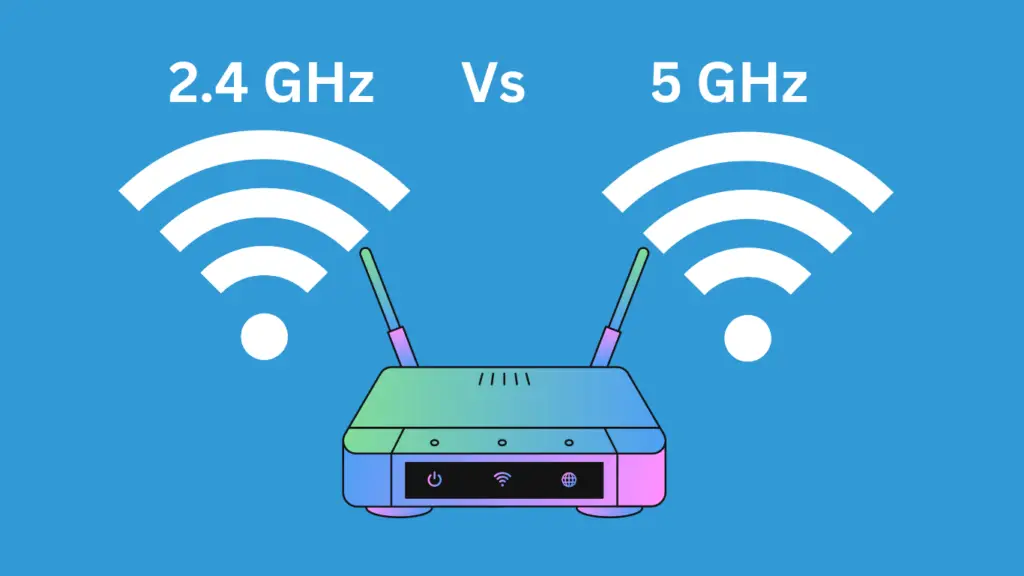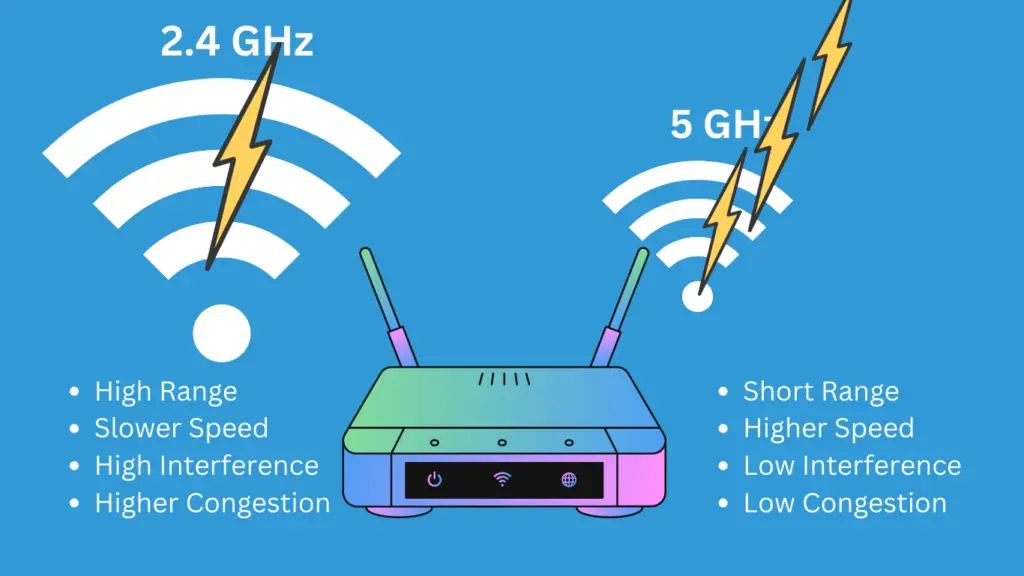Have you ever wondered why modern WiFi routers have 2.4 GHz & 5 GHz networks and which one to connect to? Or if you go around to look for a WiFi router, then you will find 2.4/5GHz routers. This can be confusing for people who do not know about WiFi bands or frequencies. That is why it is essential to understand the difference between 2.4GHz vs 5GHz WiFi.

Understanding The WiFi Bands
In this detailed guide, let’s understand WiFi bands and the difference between 2.4GHz vs 5GHz WiFi. Once we know the difference, we can use these WiFi bands in an effective manner.
WiFi bands are wireless broadcast frequencies to send and receive data. A networking device like a WiFi router can transmit data with the help of a specific frequency.
Both 2.4 GHz and 5 GHz are frequency bands for wireless transmission. These bands are basically radio waves, so your data travels in the form of radio waves.
2.4 GHz vs 5 GHz WiFi: Battle of Speed vs Range
When you look for wireless transmission, 2.4 GHz and 5 GHz frequency bands are the two options you get on any router. The speed and range are the main difference between these 2 bands. In technical terms, the range is often called coverage, and speed is known as bandwidth.

Here is the main difference between 2.4 GHz vs 5 GHz WiFi: The 2.4 GHz band provides better coverage with lower bandwidth. On the other hand, the 5 GHz band provides faster speed but shorter coverage.
2.4 GHz Band
The 2.4GHz WiFi band is great for covering larger areas. It can easily penetrate through solid objects and provides a maximum speed of around 150 Mbps.
But it lacks the data rate, so you don’t get the best speeds. Also, this band is more prone to interference. Generally, 2.4 GHz WiFi routers offer 13 channels, out of which channel 1, channel 6, and channel 13 are non-overlapping. You can set the router channel to 13 for best results.
5 GHz Band
The 5 GHz WiFi band is new compared to the 2.4 GHz band. It is great if you want faster data speeds, as it can support speeds up to 1300 Mbps. This WiFi band has significantly less interference.
However, this one is not very good at penetrating solid objects and doesn’t provide a great coverage area. Overall, many prefer this WiFi band for their homes and small spaces as it provides faster internet speeds for a small area with little interference.
2.4 GHz vs 5 GHz WiFi: Choosing the Right One for Yourself
We now know that 2.4 GHz essentially means better coverage with slower speeds. And 5 GHz means faster speeds with lower coverage. So everything comes down to bandwidth vs range when we talk about the two.

However, if you are confused about which one is going to be good for you, here are a few factors that you should keep in mind:
Size of your Space
This is one of the most important factors to count on when you are comparing 2.4 GHz & 5 GHz WiFi. If you have a really big office space or you have one of those Playboy mansions, then the 2.4 GHz band will fulfill your requirements.
However, for smaller spaces like an apartment, homes, or small offices, the 5GHz WiFi band is the best.
Speeds
The maximum speed of any WiFi network does not entirely depend on the GHz range it’s using. There are a lot of other factors that account for the overall speed of a WiFi network.
For example, the 2.4GHz band can support 450 to 600 Mbps speed. Because so many devices use the 2.4 GHz band, the network gets crowded up. As a result, you see network congestion, leading to slower speeds and discontinued connections.
On the other hand, few devices use the 5 GHz band, which can support 1300 Mbps. As many devices don’t use the 5 GHz band and it has more channels for the devices to use, it is less crowded and provides faster speeds.
The maximum speed depends on the wireless standard your access point supports. The general wireless standards are 802.11b, 802.11g, 802.11n, or 802.11ac.
The 5 GHz band has less penetrating capabilities compared to the 2.4 GHz band. The ability to penetrate solid objects like walls decreases when the frequency increases. Due to this, the 5 GHz band is mostly used outdoors. However, more frequency also means faster speeds. So if speed is your priority, then the 5 GHz band is good.
Interference Factor
The interference factor is real. If you want an efficient WiFi connection that is reliable, then you need minimum interference.
The problem with the 2.4 GHz band is that it is very prone to interference. The reason for that is: that this frequency band is used by many other devices such as routers, microwaves, Bluetooth devices, baby monitors, garage door openers, etc.
On the other hand, the 5 GHz band has lesser interferences because of less overlap with other devices. So as long as you are in a short range of the router/access point, you will face little to no interference on the 5GHz band.
Congestion
Network congestion is something similar to interference. The 2.4 GHz frequency radio space is used by many devices, so the 2.4 GHz band is more prone to congestion.
On the contrary, the 5 GHz band is less overcrowded. The 5 GHz band also has more free radio air and channels, i.e., 23 working channels, which are just 11 in the 2.4 GHz band.
Less congestion also means faster speed and a stable connection.
Use Case
The use case is also pretty important when it comes to selecting between 2.4GHz and 5GHz bands. If you just want WiFi for browsing and doing web surfing, the 2.4GHz band is great.
Although, if you want internet for gaming or streaming HD content on your devices, then 5GHz is the obvious choice.

Cost
The 5GHz band is new in the market. You will find a lot of 5GHz routers in the market these days, but they are expensive. However, the good thing is that the 5GHz routers are capable of operating at both 2.4GHz and 5GHz frequencies.
Can I Use Both 2.4GHz and 5GHz at the Same Time?
As mentioned, most new routers come with 5GHz and 2.4GHz bands. By default, you can only use one band at a time. But many routers have the option to run simultaneous dual-band. It means you can run and use both 2.4GHz and 5GHz bands at the same time.
It allows you to get maximum speed through 5GHz WiFi, and when the device is out of range, the 2.4 GHz band will come to the rescue. You should connect and save both WiFi networks, and your device will automatically switch to the most reliable WiFi network.
Why is 5GHz Faster than 2.4 GHz?
The simple reason for that is a shorter range and higher frequency. Since the 5GHz band has shorter coverage and higher frequency, the data transfer is much faster, rendering faster speeds.
Is it Better to Connect to 5GHz or 2.4 GHz?
This totally depends on a number of factors that we discussed above. In a nutshell, if you want wide coverage, then 2.4GHz is good. But if you are looking for faster speeds and a more reliable connection, then the 5GHz band is a better choice.
Conclusion
Both 5GHz and 2.4 GHz WiFi bands have advantages and disadvantages; you can use them per your use case. If the WiFi router is near you, choose the 5 GHz WiFi; if you are away, select the 2.4 GHz band.
So that was all about the difference between 2.4GHz vs 5GHz WiFi. I hope this article helps you in selecting the right router for yourself. However, I will suggest that getting a router with both 5GHz and 2.4GHz bands should be your priority. Then you won’t have to worry about such issues.
Also, Read:




